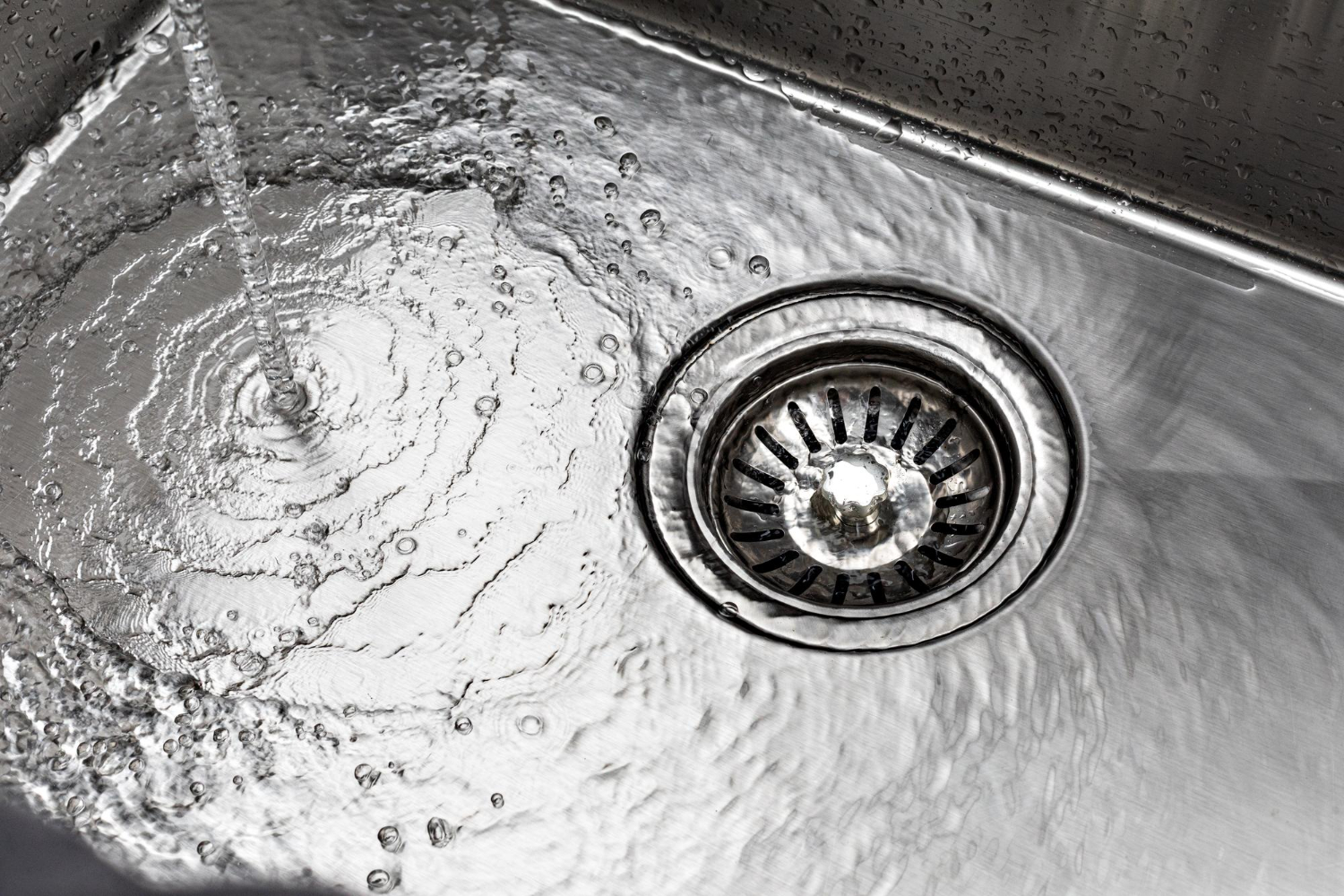


FREE Water Heater
With every whole house repipe purchase. Free brand-new water heater or credit towards a tankless water heater.
.svg)
.svg)
.svg)
.svg)



With every whole house repipe purchase. Free brand-new water heater or credit towards a tankless water heater.
.svg)
.svg)
.svg)
.svg)

Drain clogs always happen at the worst possible moments, whether you're preparing dinner or getting ready for work. The buildup of grease, hair, soap residue, and other debris creates blockages that can slow water flow or stop it completely.
Most drain clogs can be safely cleared using simple DIY methods before calling a professional plumber. Understanding when to tackle the problem yourself versus when professional help is needed can save you time, money, and prevent damage to your plumbing system.
We'll walk you through proven techniques that work, from basic maintenance steps to stronger solutions for stubborn blockages. Here’s what you’ll find below:
Keep reading! Knowing the right approach for your specific situation makes all the difference between a quick fix and a costly repair. We'll also share expert prevention tips to help you avoid future clogs and keep your drains flowing smoothly.
Hair accumulation, grease buildup, and various debris create the most frequent blockages in household drains. Mineral deposits from hard water gradually worsen these clogs by coating pipe walls and trapping additional materials.
Hair creates the most common drain blockages in bathrooms. Long strands wrap around pipe bends and catch additional debris flowing down. We see this problem worsen when hair combines with soap residue and forms thick masses.
Grease and oils solidify inside kitchen pipes after cooling down. These substances coat pipe walls and trap food particles. Common culprits include:
Debris accumulation varies by drain location. Bathroom drains collect soap scum, toothpaste, and small objects. Kitchen sinks gather food scraps, coffee grounds, and eggshells.
We find that combining materials creates the worst blockages. Hair mixed with soap forms sticky clumps. Grease traps food particles and creates solid masses. These combinations restrict water flow progressively until complete blockage occurs.
Hard water contains dissolved calcium and magnesium that deposits on pipe walls. These mineral buildup layers reduce pipe diameter and create rough surfaces that catch debris more easily.
Scale formation happens gradually over months and years. We observe thicker deposits in areas with very hard water. The mineral coating provides texture for hair and grease to stick against.
Mineral deposits also interact chemically with soap products. This reaction creates stubborn films that resist normal water pressure. The combination of minerals and soap residue forms particularly difficult blockages.
Temperature changes make mineral buildup worse. Hot water dissolves more minerals, which then precipitate as the water cools in the pipes.
Slow drainage indicates partial blockage that will worsen without intervention. Water taking more than 30 seconds to clear signals developing problems.
Standing water in sinks or tubs means significant blockage exists. This condition creates unsanitary conditions and prevents normal use.
Gurgling sounds from drains indicate air trapped by blockages. We hear these noises when water struggles past partial obstructions.
Foul odors emerge from trapped organic matter decomposing in blocked pipes. Kitchen drains smell from rotting food particles. Bathroom drains produce musty odors from hair and soap buildup.
Water backing up into other fixtures shows serious blockage in main drain lines. Multiple affected drains indicate problems beyond individual fixtures requiring immediate professional attention.
Most drain clogs can be resolved with simple household tools and natural ingredients like vinegar and baking soda. We'll cover specific techniques for different fixtures and effective methods that avoid harsh chemicals.
Hair and soap buildup are the primary culprits in shower drain clogs. We start by removing the drain cover and pulling out visible hair with needle-nose pliers or tweezers.
For deeper clogs, we use a drain snake or wire coat hanger. Insert the tool and twist while pushing down to catch hair clumps. Pull upward to extract the blockage.
Sink clogs often occur in the P-trap beneath the basin. We place a bucket under the trap and unscrew the connections. Clean out debris and reconnect the fittings.
If the clog persists, we try hot water flushing. Pour boiling water slowly down the drain in 2-3 stages. This dissolves grease and soap residue effectively.
For stubborn clogs, we combine mechanical removal with chemical-free solutions before moving to more intensive methods.
Toilet snaking requires a specific tool called a toilet auger or closet auger. We insert the rubber-coated end into the toilet bowl opening.
Push the auger cable into the drain while turning the handle clockwise. The cable navigates the toilet's internal trap to reach the blockage.
When we feel resistance, we continue turning and applying gentle pressure. The auger tip breaks apart or hooks onto the obstruction.
Important safety steps:
After clearing the blockage, we withdraw the auger slowly while continuing to turn the handle. Test the toilet with a small flush first.
According to Forbes Home, professional drain snaking typically costs about $125–$360, with difficult clogs reaching up to $800 depending on severity and access
This natural unclogging solution works through a chemical reaction that breaks down organic matter. We pour one cup of baking soda directly into the drain opening.
Follow immediately with one cup of white vinegar. The mixture will foam and bubble vigorously for several minutes.
Cover the drain with a wet cloth or stopper to contain the reaction. Let the solution work for 30 minutes to dissolve buildup.
Application steps:
We finish by pouring boiling water down the drain to wash away loosened debris. This method works best for minor clogs caused by grease, soap, or organic matter.
Repeat the process if necessary, but avoid using this method immediately after commercial drain cleaners.
When basic methods fail, you need more powerful approaches that can tackle stubborn blockages. Mechanical tools often outperform chemical solutions, while proper safety measures protect both you and your pipes.
Use a plunger first for toilet clogs and sink blockages near the surface. Plungers create pressure that dislodges debris without damaging pipes or introducing harsh chemicals.
For sink drains, we recommend a cup plunger with a flat bottom. Toilet clogs require a flange plunger with an extended rubber piece.
Chemical drain cleaners work best for organic buildup like grease, soap scum, and hair. However, we avoid them for complete blockages since they can pool and damage pipes.
Situation
Best Tool
Why
Toilet clogs
Plunger
Safe, effective, no chemicals
Surface blockages
Plunger
Quick results, reusable
Organic buildup
Enzymatic cleaner
Breaks down matter safely
Complete blockages
Drain snake
Mechanical removal
Never use chemical cleaners after plunging fails. The combination of standing water and chemicals creates hazardous conditions.
Always wear protective gear when using chemical drain cleaners. We recommend rubber gloves, safety goggles, and long sleeves to prevent skin and eye contact.
Read labels completely before opening any product. Many drain cleaners contain sulfuric acid or sodium hydroxide, which can cause severe burns.
Ensure proper ventilation by opening windows and running exhaust fans. Chemical reactions can produce toxic fumes that accumulate in enclosed spaces.
Never mix different drain cleaning products. Combining chemicals can create dangerous gases or explosive reactions.
Pour slowly and carefully to avoid splashing. Keep your face away from the drain opening to prevent fume exposure.
Store products away from children and pets. Many drain cleaners can cause serious injury if accidentally ingested or spilled.
Enzymatic cleaners break down hair naturally using bacterial enzymes. These products work slowly but safely dissolve hair without damaging pipes or creating harmful fumes.
We apply enzymatic cleaners overnight for best results. The extended contact time allows enzymes to fully break down hair proteins.
Alkaline drain cleaners containing sodium hydroxide dissolve hair quickly. However, these products generate heat and can damage certain pipe materials.
For immediate results, we use drain snakes to physically remove hair clogs. This mechanical approach works instantly and doesn't require chemicals.
Baking soda and vinegar can soften hair for easier removal. While not as powerful as commercial products, this combination is safe for regular use.
Hot water flushes help after using any hair-dissolving method. We run hot water for several minutes to clear dissolved debris from the pipes.
Professional plumbers possess specialized equipment and expertise to tackle complex drain issues that exceed basic DIY capabilities. Expert intervention becomes essential when standard methods fail, recurring problems persist, or preventive maintenance is needed.
Professional plumbers use advanced equipment that homeowners cannot access through typical retail stores. Motorized drain augers provide significantly more power than hand-cranked versions.
Hydro-jetting systems utilize high-pressure water streams to remove stubborn blockages and buildup. These machines can clear debris that simple snakes cannot dislodge.
Tool selection requires professional knowledge. Different pipe materials and clog types demand specific approaches. Using incorrect tools can transform a simple blockage into expensive pipe damage.
We recommend calling professionals when:
Professional diagnosis identifies root causes rather than treating surface symptoms. Expert assessment prevents recurring issues by addressing underlying problems in the drainage system.
Deep cleaning services remove accumulated buildup that causes frequent blockages. Professional equipment reaches areas that standard tools cannot access effectively.
Hydro-jetting eliminates grease, soap scum, and mineral deposits from pipe interiors. This process restores optimal water flow and reduces future clog formation.
Comprehensive cleaning extends beyond immediate problems. Professionals inspect entire drainage systems during service calls. They identify potential issues before they become major failures.
Cost-effectiveness becomes apparent over time. Professional deep cleaning prevents multiple service calls for recurring problems. Single comprehensive treatments often cost less than repeated DIY attempts plus eventual professional intervention.
Safety considerations favor professional service. Harsh chemical drain cleaners can damage pipes and create health hazards. Expert methods protect both plumbing systems and household safety.
Regular maintenance schedules prevent emergency situations. Professional inspections identify early warning signs before complete blockages develop. Preventive care costs significantly less than emergency repairs.
Annual or bi-annual professional cleaning maintains optimal drainage performance. Expert maintenance includes thorough system evaluation and identification of problem areas requiring attention.
Professional recommendations help homeowners avoid behaviors that contribute to clog formation. Experts provide specific guidance based on individual household drainage patterns and usage habits.
Maintenance contracts offer consistent protection. Scheduled professional service ensures drainage systems receive appropriate care throughout the year. Regular expert attention prevents small issues from becoming major problems requiring extensive repairs.
Establishing daily habits, performing regular seasonal maintenance, and using physical barriers like strainers can eliminate most drain blockages before they occur. These proactive measures cost less than emergency plumber visits and keep our plumbing systems functioning smoothly.
We can prevent most clogs by changing how we use our drains daily. Never pour grease, oil, or fat down kitchen sinks - these substances solidify in pipes and create stubborn blockages.
In bathrooms, we should remove visible hair from shower drains after each use. Hair accumulates quickly and binds with soap residue to form dense clogs.
Hot water flushes help maintain clear pipes. Running hot water for 30 seconds after each use dissolves soap buildup and pushes small debris through the system.
We must avoid flushing inappropriate items down toilets. Only toilet paper and human waste belong in these drains.
According to the U.S. EPA, fats, oils, and grease (FOG) and many so-called “flushable” wipes are a documented cause of sewer blockages and overflows; only toilet paper should be flushed
Kitchen Don'ts
Bathroom Don'ts
Grease and oils
Cotton swabs
Coffee grounds
Dental floss
Food scraps
Hair clumps
Rice and pasta
Medications
Scraping plates thoroughly before washing removes food particles that cause kitchen sink blockages.
We should perform deeper drain cleaning every three months to remove accumulating residue. Baking soda and vinegar treatments break down organic buildup naturally without harsh chemicals.
Pour one cup of baking soda down the drain, followed by one cup of white vinegar. Cover the drain for 15 minutes, then flush with hot water for two minutes.
Spring cleaning should include removing and scrubbing drain stoppers and overflow covers. Soap scum and hair collect around these components throughout winter months.
During fall preparation, we need to clear outdoor drains of leaves and debris. Blocked exterior drains can cause water backup into basement systems.
Monthly hot water flushes maintain pipe temperature and dissolve minor soap deposits. We should run the hottest tap water for three minutes in each drain location.
Professional drain inspections every two years identify developing problems before they become major clogs.
Mesh strainers provide the most effective physical barrier against drain clogs. We should install strainers in every shower, bathtub, and sink drain throughout our homes.
Kitchen sink strainers must have fine mesh to catch small food particles. Stainless steel models resist corrosion and last longer than plastic alternatives.
Bathroom strainers need larger openings to handle hair while allowing water flow. We should choose strainers with removable baskets for easy cleaning.
Pop-up strainers work well for tubs where permanent installation is preferred. These devices catch hair while maintaining the drain's original appearance.
We must clean strainers weekly to prevent overflow and maintain effectiveness. Accumulated debris on strainer surfaces can force water to back up.
Replacement schedules matter. Plastic strainers typically need replacement every 12 months, while metal versions last 3-5 years with proper maintenance.
Some strainers include built-in disposal mechanisms that grind small particles, though these require electrical connections and professional installation.
Clogged drains don't have to become expensive plumbing emergencies. We can handle most blockages with simple, safe methods when we act quickly.
Start with gentle approaches like hot water flushes and plungers. These methods protect our pipes while clearing common clogs effectively.
Avoid harsh chemicals that can damage plumbing systems. Commercial drain cleaners often cause more problems than they solve in aging pipes.
We should recognize when professional help is necessary. Multiple clogged drains, recurring blockages, or sewage odors indicate larger system issues.
Prevention remains our best strategy. Regular maintenance and mindful disposal habits prevent most drain problems before they start.
We can maintain healthy plumbing systems by combining proper prevention techniques with safe unclogging methods. Quick action on minor clogs prevents major repairs.
Our drains will function properly when we use the right approach for each situation. Simple maintenance and informed responses keep our plumbing systems running smoothly.
Call Sunshine Services now for same-day clogged drain service, schedule your appointment or request an upfront, itemized quote.